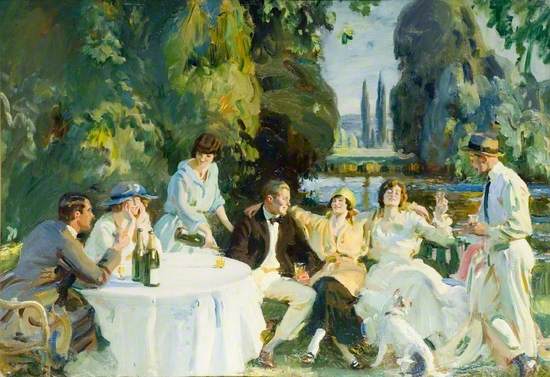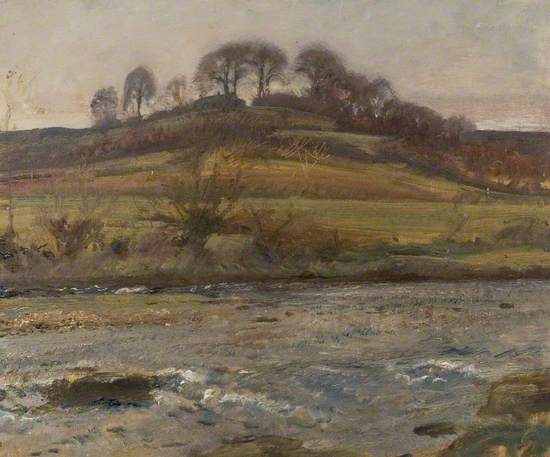Sir Alfred Munnings is most well known as a painter of horses. His equestrian portraits, scenes of the hunt and racing starts brought him great wealth and fame. Less known, perhaps, was his love of painting landscapes, particularly the river.
Naturally and creatively Munnings gravitated to ‘the river’ which became a constant motif in his paintings, throughout his life, wherever he lived. Frequently painted for his own pleasure they reveal his masterly skills at capturing movement and the effects of light upon the surface of the water.
This Curation, by Curatorial Associate Marcia Whiting, explores and celebrates Munnings’ artistic responses to the river, for which he held such an affinity.
September Afternoon on the Stour: The White Canoe
Munnings painted September Afternoon at the height of his career. In contrast to the restrictive demands of commissioned works, for which he was in great demand, this was a work painted for his own pleasure on the river Stour near his home in Dedham, Essex.
He returned to the impressionistic style of earlier paintings and his pre-occupation with capturing the ever-changing effects of light on motifs.
Alfred James Munnings (1878–1959)
Oil on canvas
H 100.3 x W 125.7 cm
The Munnings Art Museum
.

Before the ‘roger’
An early rare example of pen and ink illustration by Munnings which featured in a book of short stories titled Told at Twilight by Nicholas Everitt, published in 1904.
Before the ‘roger’, c.1904, Alfred James Munnings (1878–1959), Pen and Ink on paper, H 10.5 x W 20 cm, The Munnings Art Museum
Path to the Orchard
The river Waveney, on the border of Suffolk and Norfolk, inspired Munnings to paint some of his most enduring and iconic early works. The location for Path to the Orchard was the tow path of his childhood home at Mendham Mill situated on the Waveney.
The pony in the painting, ‘Augereau’, was one of Munnings favourite models and appears in many early works.
Alfred James Munnings (1878–1959)
Oil on canvas
H 76.2 x W 106.7 cm
The Munnings Art Museum
The Ford
Two locations on the river Waveney were used as the backdrop for this painting.
“The grey-weather subject I prepared for was ‘The Ford’ - grey water and dark reflections broken by lines of the current.”
Alfred James Munnings (1878–1959)
Oil on canvas
H 134.6 x W 162.6 cm
The Munnings Art Museum
Poplars, River Waveney
“Pattering sound of poplars and the rustling reeds fringing dark, still stretches of river with steely, shimmering, wind- touched surface…”
Alfred James Munnings (1878–1959)
Oil on canvas
H 64.8 x W 71.8 cm
The Munnings Art Museum
Cows at Water, Lamorna
In 1911 Munnings moved to Lamorna in Cornwall. The stream which flows through Lamorna Valley is likely to have been where he painted this bucolic scene. He recalled:
“…the high sunlight piercing foliage, flashing on a leaf and stalk – throwing pools of light on transparent, rippling, sandy shallows.”
Alfred James Munnings (1878–1959)
Oil on canvas
H 35.6 x W 43.2 cm
The Munnings Art Museum
.

Horses going over a Bridge
In 1918, as an official war artist, Munnings painted the Canadian Cavalry Brigade in Northern France. He frequently used the river as an anchor for his paintings of soldiers and horses, which resulted from the many studies he made.
Horses going over a Bridge, 1918, Alfred James Munnings (1878–1959), Pencil on paper, (sketchbook page), H 23.5 x W 31 cm, The Munnings Art Museum
Tagg's Island
A sun-filled and joyous conversation piece painted on the cusp of the ‘Roaring Twenties’. Taggs Island is nestled in the river Thames a short distance from Hampton Court Palace.
Alfred James Munnings (1878–1959)
Oil on canvas
H 88.9 x W 127 cm
The Munnings Art Museum
The White Canoe on the Stour at Flatford
Munnings growing success as a painter enabled him to purchase Castle House in Dedham, Essex in 1919. Situated close to the river Stour he called his home “The house of my dreams” and lived there until his death in 1959. This painting of his wife Violet and a friend is one of his early scenes of the Stour, many more were to follow over the next 40 years.
Alfred James Munnings (1878–1959)
Oil on canvas
H 50.8 x W 60.3 cm
The Munnings Art Museum
Floods near Nayland
A sense of modernity and experimentation is created by Munnings exceptionally loose handling of paint to depict the flooded river and reflections of trees.
Alfred James Munnings (1878–1959)
Oil on canvas
H 57.2 x W 72.4 cm
The Munnings Art Museum
A Barge on the Stour at Dedham
“Always I have loved a river, … peace can still be sought and found by the banks of the Stour.”
Alfred James Munnings (1878–1959)
Oil on canvas
H 61 x W 81.3 cm
The Munnings Art Museum
Brightworthy Ford, Withypool, Exmoor
On the outbreak of the Second World War, Munnings home in Dedham was requisitioned by the army. He and his wife Violet moved to their home on Exmoor where he began a series of works of Brightworthy Ford on the river Barle.
Alfred James Munnings (1878–1959)
Oil on board
H 50.8 x W 61 cm
The Munnings Art Museum
Brightworthy Ford, Withypool, Exmoor
“This is only something of what the eye sees whilst the never-ceasing music of the running river goes on and on - a background of sound to the bird songs.”
Alfred James Munnings (1878–1959)
Oil on board
H 44.5 x W 60.3 cm
The Munnings Art Museum
Bagsworthy (sic) Water, Exmoor
Fir-cones, teasels, chewed ends of pieces of wood and paint rags tied on sticks were the tools with which Munnings painted this scene at Badgworthy Water on Exmoor having forgotten his brushes that morning!
Alfred James Munnings (1878–1959)
Oil on board
H 50.2 x W 61 cm
The Munnings Art Museum
Marcia Whiting is a Curatorial Associate at The Munnings Art Museum, in Dedham. She has a First Class Honours Degree in the ‘History and Theory of Visual Art’ and is a member of the Association for Art History. Her role at the Museum includes Research into Munnings’ life and paintings as well as Curating Exhibitions and re-hanging the Museum Displays from Season to Season.
For more information, buy Marcia's book 'Munnings and the River' on Art UK http://artuk.org/.../product/munnings-and-the-river.html
Published in 2017, to accompany a successful exhibition of the same title, this book explores Munnings artistic and literary responses to the river, a subject for which he held such personal affection and affinity, that it remained a con












